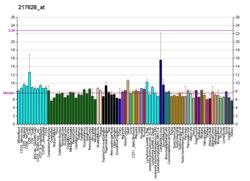
Chloride channels are a superfamily of poorly understood ion channels specific for chloride. These channels may conduct many different ions, but are named for chloride because its concentration in vivo is much higher than other anions. Several families of voltage-gated channels and ligand-gated channels have been characterized in humans.

Transient receptor potential cation channel, subfamily C, member 6 or Transient receptor potential canonical 6, also known as TRPC6, is a protein encoded in the human by the TRPC6 gene. TRPC6 is a transient receptor potential channel of the classical TRPC subfamily.

Ezrin also known as cytovillin or villin-2 is a protein that in humans is encoded by the EZR gene.

Sodium-hydrogen antiporter 3 regulator 1 is a regulator of Sodium-hydrogen antiporter 3. It is encoded by the gene SLC9A3R1. It is also known as ERM Binding Protein 50 (EBP50) or Na+/H+ Exchanger Regulatory Factor (NHERF1). It is believed to interact via long-range allostery, involving significant protein dynamics.

Alpha-actinin-1 is a protein that in humans is encoded by the ACTN1 gene.

Moesin is a protein that in humans is encoded by the MSN gene.

Chloride intracellular channel protein 1 is a protein that in humans is encoded by the CLIC1 gene.

Podocalyxin-like protein 1 is a protein that in humans is encoded by the PODXL gene.

Chloride intracellular channel 4, also known as CLIC4,p644H1,HuH1, is a eukaryotic gene.

Chloride channel protein 2 is a protein that in humans is encoded by the CLCN2 gene. Mutations of this gene have been found to cause leukoencephalopathy and Idiopathic generalised epilepsy, although the latter claim has been disputed. CLCN2 contains a transmembrane region that is involved in chloride ion transport as well two intracellular copies of the CBS domain.

H+/Cl− exchange transporter 3 is a protein that in humans is encoded by the CLCN3 gene.

Synaptopodin is a protein that in humans is encoded by the SYNPO gene.

TRIO and F-actin-binding protein is a protein that in humans is encoded by the TRIOBP gene.

Chloride intracellular channel protein 2 is a protein that in humans is encoded by the CLIC2 gene.

Formin-binding protein 1-like is a protein that in humans is encoded by the FNBP1L gene.

Prostaglandin F2 receptor negative regulator is a protein that in humans is encoded by the PTGFRN gene. PTGFRN has also been designated as CD315.

F-actin-capping protein subunit alpha-2 also known as CapZ-alpha2 is a protein that in humans is encoded by the CAPZA2 gene.

Spectrin, beta, non-erythrocytic 4, also known as SPTBN4, is a protein that in humans is encoded by the SPTBN4 gene.

Chloride intracellular channel protein 6 is a protein that in humans is encoded by the CLIC6 gene.

Chloride intracellular channel protein 3 is a protein that in humans is encoded by the CLIC3 gene. This protein is a chloride channel.























